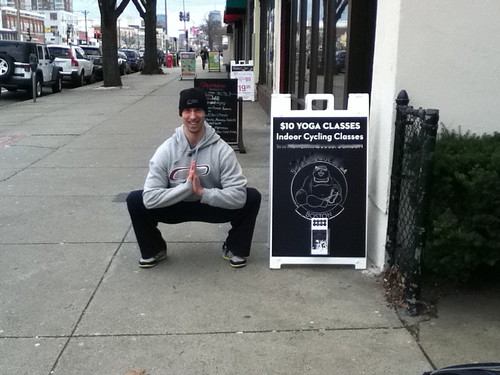I like to think that as a strength coach I’m wiser now than I was ten, five, hell, even two years ago.
There’s stuff that I poo-poo’ed back in the day, only to do a complete 180 later on once I got past my own prejudices and got my head out of my own ass.
Take yoga for example. While there’s still a large percentage of me that feels it’s not a good fit for some people – and I wholeheartedly cringe at how it’s marketed towards women as the end-all-be-all panacea of health – I’ve changed my mind in many ways.
I don’t feel it’s the spawn of Hitler as I used to believe.
It DOES have a place. And if someone likes yoga, and wants to do it, who am I to judge?
I still feel it’s woefully OVERemphasized, and there are a lot of people out there (not all) who make a lot of silly claims (“yoga builds long, lean muscles!”), but my older, less cynical self does appreciate that it provides a plethora of benefits.
For those interested, you can check out my Tony Takes a Yoga Class Part I and Part II.

Another example would be CrossFit. Like a lot of strength coaches, there’s quite a bit about CrossFit that I don’t agree with – lack of assessment and progression, ridiculous WODs, little to no sense of structure with regards to coherent programming.
This isn’t representative of ALL CrossFit affiliates, of course, but a far portion of them.
However, I’d be remiss not to recognize that there is a lot of good about CrossFit too. I actually wrote a post DEFENDING CrossFit HERE.
Bringing the discussion to specific exercises, 80% of people will have some form of lower back pain at some point in their lives. At any given moment, 1 in 3 are experiencing lower back pain NOW.
While lower back pain can be attributed to any number of things – aberrant motor patterns, mobility/stability deficits, lack of spinal endurance, blunt trauma, or global warming, to name a few – I’d go so far as to say that 75% of those people (the ones who are physically active anyways) will usually point their finger at one specific training session where they tweaked their back performing either a squat or a deadlift.
Not surprisingly, these are the same people who will scour the message boards, tirelessly, warning people of the dangers of squatting and deadlifting.
Of course, if we were to dig deeper, we’d find out that their version of a deadlift is more like a “lets see how much we can round our back while lifting this bar off the floor” doohickey.
Nonetheless, the point I’m trying to make is that it’s rarely the exercise that’s the problem – it’s the lifter.
Both Eric and myself have always stated that there’s really no such thing as a contraindicated exercise, rather there are contraindicated exercisers.
I believe EVERYONE should learn how to squat and deadlift.
Both are basic human movement patterns that, for whatever reason: whether it’s poor mobility, some sort of kinetic dysfunction, inactive lifestyle, lack of core stability, tight this, stiff that – many people have forgotten how to do properly.
It doesn’t mean, though, they can’t re-learn it.
Moreover, the same can be said about anyone with limited hip or thoracic mobility -which can make deadlifting from the floor a bit problematic.
Instead of trying to hammer square pegs into round holes, we can use something like the trap bar (with an elevated setting) which makes things infinitely more manageable, and safer.
Matter of fact, we don’t have to limit this to just squats and deadlifts. Someone’s shoulder hurts when they bench? The simple answer would be to tell them to:
– Stop benching every Monday, Tuesday, Wednesday, Thursday, Friday, and every other Saturday.
– Implement more horizontal rowing into the mix, to the tune of 2:1, or even a 3:1 (pull/push) ratio.
– Push-ups, push-ups, and more push-ups.
– Work on their technique, cause it sucks.
– Add in more dynamic stabilization drills for the rotator cuff, like THIS.
– Get some aggressive soft-tissue therapy done, whether it’s Graston, ART, or massage.
Okay, so it’s not that simple.
Since most are going to bench anyways, why not show them some better alternatives, like floor presses or board presses?
They’ll still be able to “bench,” albeit with infinitely less stress on the shoulders. Along with the stuff mentioned above, in a matter of weeks, they could be back to benching pain-free in no time!
Using ONE more example, “Ten years ago Tony” would probably want to drop-kick present-day Tony in the face for saying this, but, everything has an appropriate time and place: leg presses, leg extensions, leg curls, and, sadly, even BOSU balls.
Yes, I said BOSU balls.
None of the aforementioned items mentioned above would be my first choice when building a program for someone who’s healthy, but they DO have a time and place.
In the end, it comes down to understanding that there are contraindicated lifters, not contraindicated exercises.
Understanding this point, as well as being able to make the necessary progressions, is oftentimes what separates the great trainers from the not so great.
Which is why I’d like you to read my latest article on Stack, which discusses why back squats MAY not be such a great fit for baseball players.



